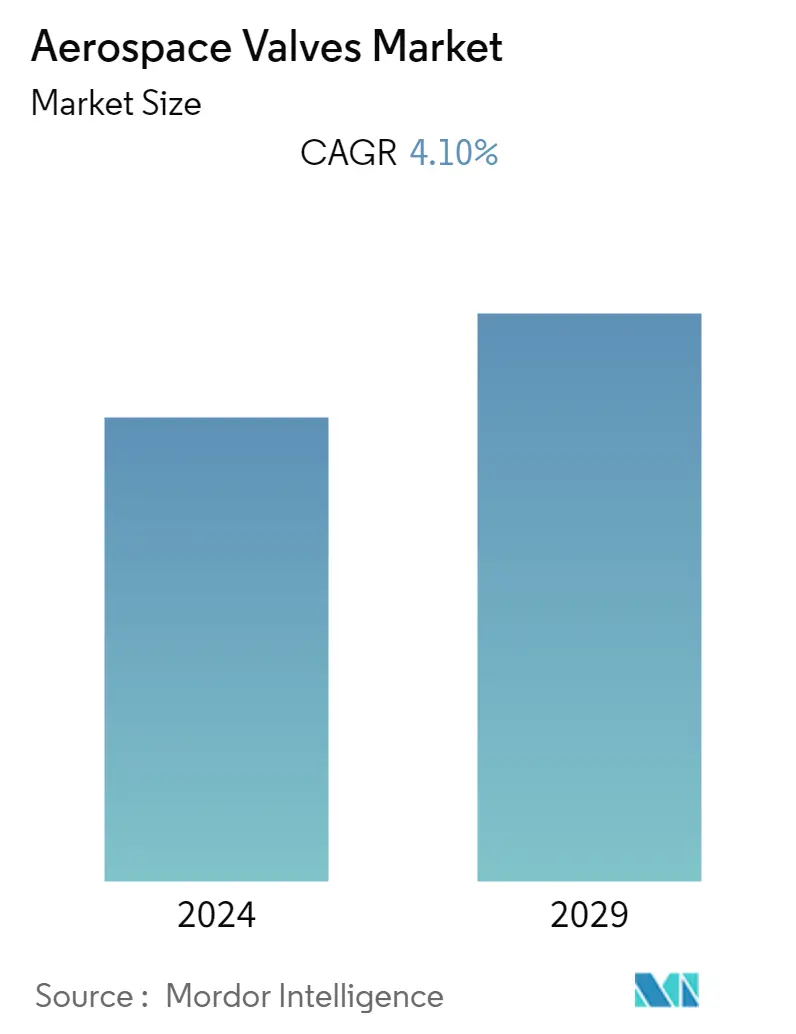Market Size of Aerospace Valves Industry

| Study Period | 2019 - 2029 |
| Base Year For Estimation | 2023 |
| CAGR | 4.10 % |
| Fastest Growing Market | Asia-Pacific |
| Largest Market | North America |
| Market Concentration | Medium |
Major Players
*Disclaimer: Major Players sorted in no particular order |
Aerospace Valves Market Analysis
The Aircraft Valves Market is anticipated to grow at a CAGR of 4.1% during the forecast period.
- The decrease in the COVID-19 pandemic had increased passenger numbers at the airport. Removal of border restrictions by various governments, as well as ease in restrictions for travel, was the main factor for such growth, and this has led to various aircraft OEMs being able to increase production of the aircraft and meeting the delivery timelines, which has, in turn, led to an increase in the demand for aircraft valves. In addition, opening the barriers by various countries also led to free flow in terms of the supply of the necessary components required to produce aircraft valves. This has resulted in the aircraft valves market witnessing steady growth during the forecast period.
- An increase in the number of air passenger traffic worldwide has led to increased stress on airports globally to cope with the rise in passenger demand. Various aircraft OEMs are now increasing the production of the new generation of aircraft and are trying to meet their aircraft delivery deadlines. Moreover, an increasing global commercial aircraft fleet size due to rising air passenger traffic is giving an impetus to the replacement demand for aerospace valves, especially from maintenance, repair, and overhaul companies. Aerospace valves are exposed to wear and tear during continuous flight operations and are generally replaced rather than repaired. Currently, there is also a significant market opportunity to integrate the Internet of Things (IOTs) among aerospace valves to improve performance, enhance reliability, smooth functioning, and significantly reduce lifecycle costs. Proactive failure detection and predictive maintenance record with IOTs help in proper and timely repairs to the valves, thereby enabling better discrete functioning with effective data-based decision-making.
Aerospace Valves Industry Segmentation
The valves in an engine, known as engine valves, are designed to balance and control the flow of gasses that come into and out of the cylinders located in the engine. They are intended to regulate the gas levels during the engine's combustion process. In basic terms, they serve to open and close a portal for air or gas coming in and out of the engine. Valves are often classified by the shape of the head, which may be flat, mushroom-type, tulip, or semi-tulip. Additionally, intake valves, for instance, must operate at lower temperatures than exhaust valves, usually made up of nickel, chrome, or tungsten steel. In contrast, the exhaust valves must withstand higher temperatures, which means they must be made of a more heat-resistant material, like silicon-chromium, cobalt-chromium alloys, or Inconel.
Additionally, the market has been segmented by valve, aircraft, application, and geography. By valve type, the market has been segmented by butterfly valve, ball valve, rotary valve, gate valve, and others. By aircraft type, the market has been segmented into commercial aircraft, general aviation aircraft, business aircraft, military aircraft, and helicopters. By application, the market has been segmented by the fuel system, hydraulic system, pneumatic system, and others. By geography, the market has been segmented by North America, Europe, Asia-Pacific, Latin America, the Middle East and Africa. The report offers a market forecast and is represented by USD million. Furthermore, the report also includes various key statistics on the market status of leading market players and provides key trends and opportunities in the aircraft valves market.
| By Valve Type | |
| Butterfly Valve | |
| Ball Valve | |
| Rotary Valve | |
| Gate Valve | |
| Others |
| By Aircraft Type | |
| Commercial Aircraft | |
| General Aviation Aircraft | |
| Business Aircraft | |
| Military Aircraft | |
| Helicopters |
| By Application | |
| Fuel System | |
| Hydraulic System | |
| Pneumatic System | |
| Others |
| By Geography | |||||||
| |||||||
| |||||||
| |||||||
| |||||||
|
Aerospace Valves Market Size Summary
The aerospace valves market is poised for steady growth, driven by the resurgence in air travel and the subsequent increase in aircraft production. The easing of COVID-19 restrictions has led to a rise in passenger traffic, prompting aircraft original equipment manufacturers (OEMs) to ramp up production to meet delivery schedules. This surge in demand for aircraft has, in turn, boosted the need for aerospace valves, as these components are crucial for the efficient operation of aircraft systems. The market is also benefiting from the global expansion of the commercial aircraft fleet, which is creating a replacement demand for valves, particularly from maintenance, repair, and overhaul companies. The integration of Internet of Things (IoT) technologies into aerospace valves presents a significant opportunity to enhance their performance and reliability, offering proactive failure detection and predictive maintenance capabilities.
The butterfly valve segment is expected to experience significant growth due to its extensive application in aircraft fuel and pneumatic systems. These valves are favored for their compact size and ease of use, making them ideal for aviation applications where space is limited. The United States is anticipated to be the largest market for aerospace valves, supported by a robust presence of manufacturers and a strong aviation industry infrastructure. The demand for lightweight and high-performance valves is increasing, driven by the need to support modern aircraft platforms. The presence of major players like Honeywell International and Triumph Group, along with strategic investments in the aviation sector, is expected to further propel market growth. Companies are focusing on innovation and technology integration to enhance the capabilities of new aircraft models, ensuring continued expansion in the aerospace valves market.
Aerospace Valves Market Size - Table of Contents
-
1. Market Dynamics
-
1.1 Market Overview
-
1.2 Market Drivers
-
1.3 Market Restraints
-
1.4 Industry Attractiveness - Porter's Five Forces Analysis
-
1.4.1 Threat of New Entrants
-
1.4.2 Bargaining Power of Buyers/Consumers
-
1.4.3 Bargaining Power of Suppliers
-
1.4.4 Threat of Substitute Products
-
1.4.5 Intensity of Competitive Rivalry
-
-
-
2. Market Segmentation
-
2.1 By Valve Type
-
2.1.1 Butterfly Valve
-
2.1.2 Ball Valve
-
2.1.3 Rotary Valve
-
2.1.4 Gate Valve
-
2.1.5 Others
-
-
2.2 By Aircraft Type
-
2.2.1 Commercial Aircraft
-
2.2.2 General Aviation Aircraft
-
2.2.3 Business Aircraft
-
2.2.4 Military Aircraft
-
2.2.5 Helicopters
-
-
2.3 By Application
-
2.3.1 Fuel System
-
2.3.2 Hydraulic System
-
2.3.3 Pneumatic System
-
2.3.4 Others
-
-
2.4 By Geography
-
2.4.1 North America
-
2.4.1.1 United States
-
2.4.1.2 Canada
-
-
2.4.2 Europe
-
2.4.2.1 Germany
-
2.4.2.2 United Kingdom
-
2.4.2.3 France
-
2.4.2.4 Rest of Europe
-
-
2.4.3 Asia-Pacific
-
2.4.3.1 China
-
2.4.3.2 India
-
2.4.3.3 Japan
-
2.4.3.4 Australia
-
2.4.3.5 Rest of Asia-Pacific
-
-
2.4.4 Latin America
-
2.4.4.1 Mexico
-
2.4.4.2 Brazil
-
-
2.4.5 Middle East and Africa
-
2.4.5.1 United Arab Emirates
-
2.4.5.2 Saudi Arabia
-
2.4.5.3 South Africa
-
2.4.5.4 Rest of Middle East and Africa
-
-
-
Aerospace Valves Market Size FAQs
What is the current Aerospace Valves Market size?
The Aerospace Valves Market is projected to register a CAGR of 4.10% during the forecast period (2024-2029)
Who are the key players in Aerospace Valves Market?
Eaton Corporation PLC, Triumph Group, Sitec Aerospace GmbH , Safran SE and Woodwork Inc. are the major companies operating in the Aerospace Valves Market.

